Join North East England Blue Badge Tourist Guide, Ruth Robson as she explores the links between The Northern Saints Trails and the ancient Camino de Santiago pilgrimage route.
Have you ever wanted to walk the Camino de Santiago? Did you know you can start your journey in Durham and finish in Spain at Santiago de Compostela? Or if discovering more about the Northern Saints is your intent, you can complete your whole journey in North East England crossing dales, hills, rivers and coastline with Durham Cathedral as your final destination.
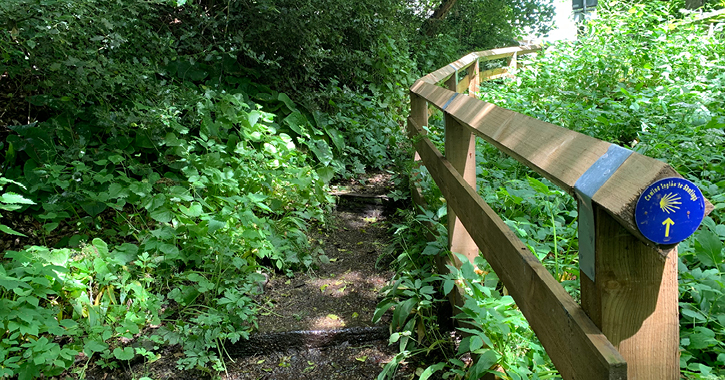
The Finchale Camino is officially recognised as part of the Camino Ingles – the English Way, an ancient network of pilgrimage routes centred on Santiago de Compostela, the capital of northwest Spain’s Galicia region with its amazing Cathedral and shrine to St James.
To be recognised as having walked the Camino de Santiago pilgrims are required to complete a distance of 100km (62 miles) collecting stamps in a special passport en route.
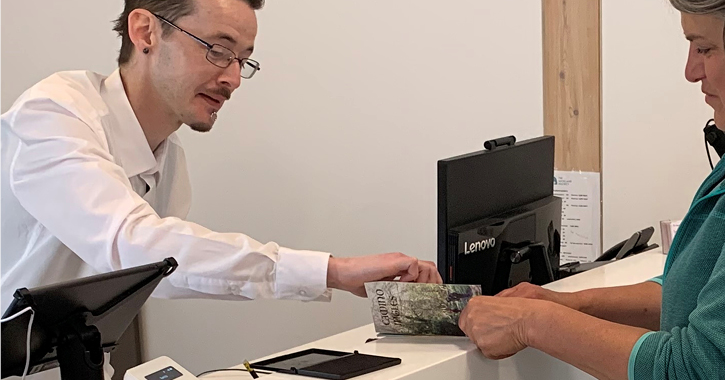
There are various Caminos leading to Santiago; from France, Portugal, southern Spain and the Camino Ingles – The English Way, which includes the 33-mile Finchale Camino starting at Finchale Priory and finishing at Gainford. The stretch can be completed in three to four days along a route incorporating both pilgrimage and heritage sites, including Durham Cathedral, at the centre of the Durham UNESCO World Heritage Site; idyllic countryside walks, towns, villages and settlements, and of course plenty of opportunities for refreshment along the way.
Once pilgrims have completed the stretch in Durham, pilgrims can travel on to Galicia in Spain to walk from the port cities of Ferrol or A Coruña southward to Santiago de Compostela. Medieval pilgrims from England would travel by boat from the south coast to either of these cities and then complete their journey on foot to the Cathedral of Santiago de Compostela, which like Durham Cathedral is at the heart of a UNESCO World Heritage Site.
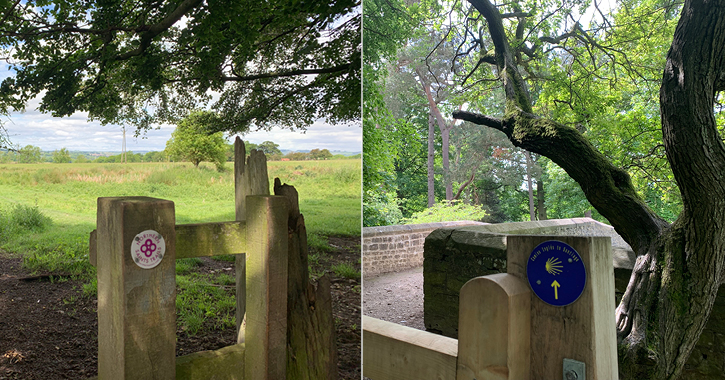
The Finchale Camino and two of the Northern Saints Trails overlap.
- Walking southward from Finchale Priory through Durham City and Bishop Auckland onto Gainford is part of the Camino Ingles.
- Walking northwards from Gainford in reverse to Durham Cathedral is part of The Way of Life.
- Walking southwards from St Peter’s Church, Sunderland via Chester-le-Street and Finchale Abbey onwards to Durham Cathedral is part of The Way of Learning.
Whichever direction you travel there are experiences to be savoured along the way.
Finchale, which gives its name to the stretch of the Camino in Durham, was home to St Godric. He was born in 1065 in Norfolk rising from a peddler to a ship’s captain. It was a sea faring mission that led to an encounter with St Cuthbert on Lindisfarne, the famous tidal island off the Northumberland coast. It was there, the place that St Cuthbert was buried after his death in 687, where Godric had a vision and a calling to devote himself to Christianity.
He captained pilgrimage voyages to Rome, Jerusalem and to Santiago before settling as a hermit at Finchale, having been given permission to use the land from Ranulf Flambard, Bishop of Durham. Godric lived for another sixty years dying in 1170, over a hundred years old. He lived on herbs, crab apples, honey and nuts and is famous as a musician. St Godric composed the oldest songs in the English language for which we have the original musical scores which are held at the British Library.
Finchale Priory was founded in 1176, after Godric’s death, as a retreat house for the monks of Durham until it’s suppression as part of the Dissolution of the Monasteries in 1538. We know so much about Godric because his life was documented by the 12th century monk Reginald of Durham, who also wrote about the miracles of St Cuthbert.
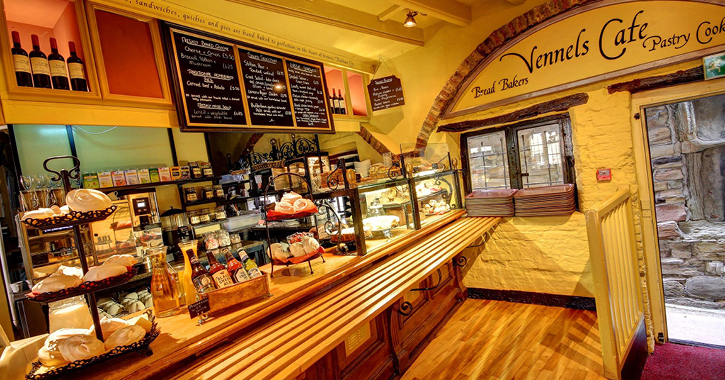
Four miles south of Finchale is Durham City and its stunning World Heritage Site. Durham is full of delightful cafes and eateries. A favourite of mine is Vennels, which takes its name from a French word venelle which means ‘little street’.
Vennels is found along a narrow ‘little street’ off Saddler Street. It offers indoor eating in a fascinating 16th century building, and outdoor eating in Saddlers’ Yard. It also has links to the invention of English mustard, and the technique of grinding mustard seeds into a fine powder which is then mixed into a pungent paste. It was first used by a Mrs Clements of Durham in 1720, with her mustard becoming a favourite of King George 1st. The company took her son in law’s name Ainsley and was eventually sold to Coleman’s of Norwich.
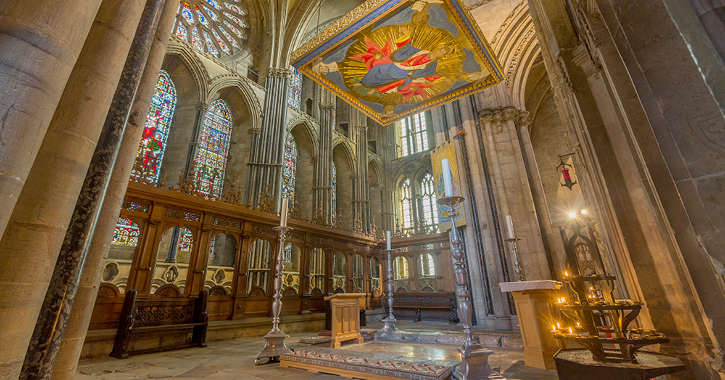
After providing an opportunity to pay homage to St Cuthbert at Durham Cathedral, the Finchale Camino continues south. The route leaves Durham City via Mount Joy, so called because as ancient pilgrims approached Durham City from the south it offers a ‘joyous’ view of Durham Cathedral. Make sure to stop and ‘enjoy’.
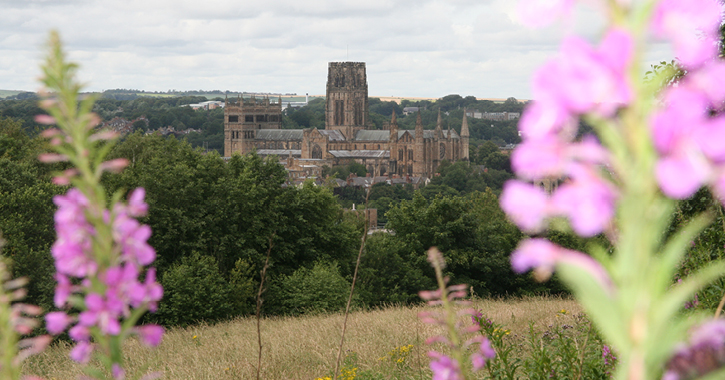
The route winds its way southwest of Durham City passing through the village of Byers Green. Take time to look at the blue plaque celebrating the life of Thomas Wright, born in the county in 1711 and was the first astronomer to describe the Milky Way.
This homage to the stars is appropriate given the Finchale Camino’s link to the Santiago de Compostela. The meaning of Compostela is most likely derived from Latin ‘Composita Tella’ meaning ‘burial ground’ and in the case of Santiago, the burial ground of St James. Another folk meaning of the word Compostela is from the Latin ‘Campus Stellae’ meaning ‘field of stars’. It seems appropriate that the site of the birthplace of someone famous for documenting one of the most famous ‘field of stars’ is part of the Camino Ingles, the English Way.
.jpg)
The Finchale Camino takes in both ancient and modern. An historic site it passes is Binchester Roman Fort or to give it it’s Roman name Vinovia. It marks the crossing of the ancient Roman Road of Dere Street and the River Wear. Dere Street starts at Eboracum, more commonly known as York running north to Hadrian’s Wall and onwards into Scotland. Binchester Roman Fort has an amazing bathhouse, preserved within a wooden structure built over the site, protecting it for future generations to enjoy.
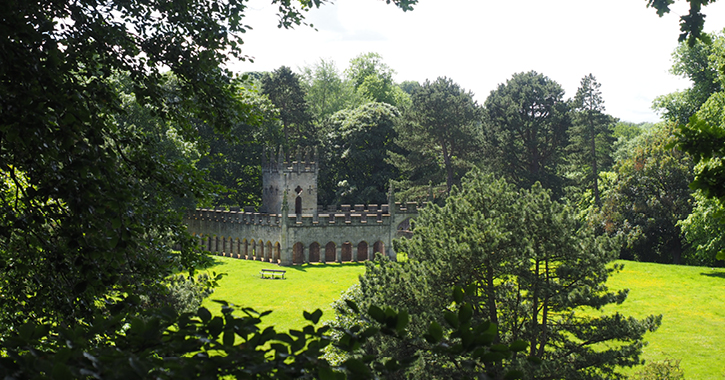
Binchester is immediately north of Bishop Auckland, with the Finchale Camino leading into the town via a medieval deer park, once the hunting grounds of the Bishops of Durham. There is a highly unusual structure within the park built by Bishop Trevor, Bishop of Durham from 1752 to 1771. A deer house, built in the gothic style, created as a place where deer could rest and feed, also provided upper-level rooms where Bishop Trevor and his guests could picnic and view the grounds of Auckland Castle and surrounding countryside.
Auckland Castle was the Bishop of Durham’s country residence, becoming the permanent home to the Bishop of Durham when the Bishop William Van Mildert and the Chapter of Durham Cathedral formed Durham University in 1832 ahead of it becoming an independent institution in the early 20th century. Bishop William gave up his palace Durham Castle, with it becoming the first college of Durham University.
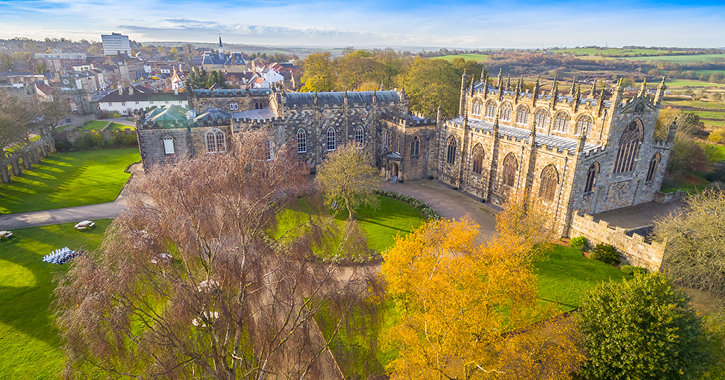
Bishop William took up residence at Auckland Castle and the Bishop of Durham to this day continues to have administrative space in Bishop Auckland though the castle itself has become part of The Auckland Project, a multi-million-pound conservation and investment programme in Bishop Auckland led by a charitable trust created by philanthropist Jonathan Ruffer.
Bishop Trevor, the creator of the Deer House, was a supporter of the Jewish Repatriation Act of the 1753, taking a keen interest in Jewish matters to encourage mutual understanding of world religions. He purchased 13 paintings by the Spanish artist Francisco de Zurbarán depicting the figures of Jacob and his sons which feature in both the Christian bible’s Old Testament and the Tanakh, Jewish scriptures. The Zurbarán paintings are one of the many highlights of Auckland Castle.
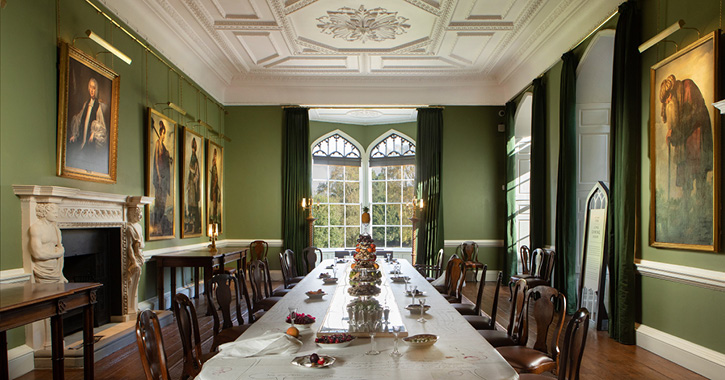
Developments in the town itself include The Spanish Gallery, telling the story of the golden age of Spanish Art, and The Mining Gallery, home to collections of mining art. Both galleries offer a programme of temporary exhibitions as well permanent collections. A favourite work of mine is Berriman’s Chip Van by Norman Cornish.
Norman Cornish painted the van on a number of occasions, with day-to-day life in his home town of Spennymoor central to his work. The Chip Van itself survives and has been lovingly restored and is on display at Beamish, The Living Museum of the North.
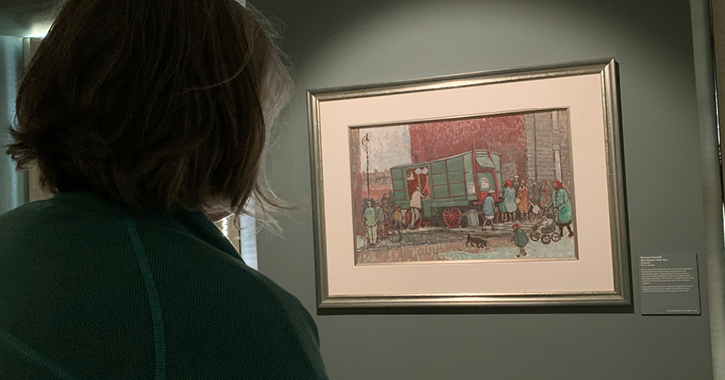
A contemporary visitor centre, Auckland Tower, is inspired by a medieval siege engine, which will have been commonly used across North East England in warfare, often against the Scots and in some instances during significant moments in the War of the Roses, when two strands of the Plantagenet blood line fought against each other for the crown of England.
The tower has a viewing platform offering stunning views of Bishop Auckland and the srrounding countryside. You can also get your Camino and Northern Saints Trails passport stamped inside the tower. Nearby Bishop Auckland Town Hall hosts a cinema, theatre, art gallery, library and a variety of spaces for community events. Not least Bishop Auckland offers an array of cafes and restaurants, perfect for a rest and something to eat.
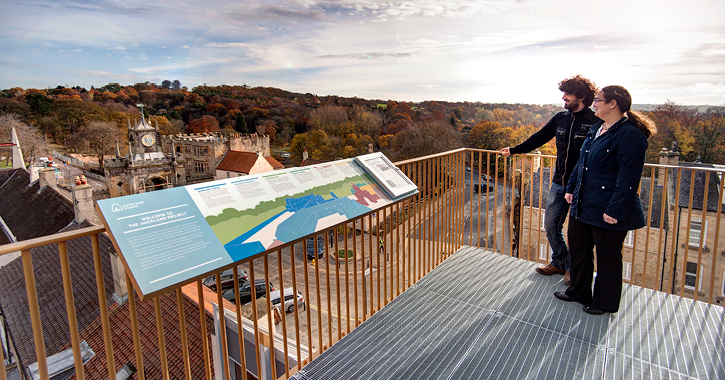
The route then follows the River Wear upstream to the west for a few miles leading to Escomb Saxon Church, one of Durham’s architectural gems. It is one of only three complete Anglo-Saxon 7th century churches that survive in Britain. Its dedication is unclear and is usually referred to as Escomb Saxon Church, rather than a particular saint’s name.
Archaeological work in the 1968 revealed a variety of interesting aspects of the building’s history. A connection I particularly like is a link to the twin monasteries of Monkwearmouth Jarrow, which can be visited on The Way of Learning.
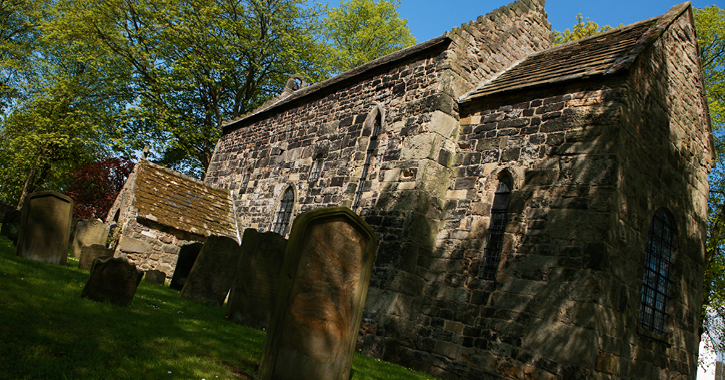
Eight fragments of Anglo-Saxon window glass were found in at Escomb Saxon Church identical to fragments found at Monkwearmouth Jarrow. This implies that like the churches of St Peter’s, Monkwearmouth and St Paul’s, Jarrow, that Escomb Saxon Church probably had early glazed windows.
7th century Benedict Biscop was the first abbot of Monkwearmouth Jarrow and quoting from the writing of Venerable Bede, we know that Benedict Biscop sent “messengers to Gaul to fetch glaziers, craftsmen who were at this time unknown in Britain, that they might glaze the windows of his church, choir and refectory. This was done and they came, and they not only finished the work required, but from this caused the English to know and learn their handicraft.”
2025 will be the 200th anniversary of the Stockton and Darlington Railway and the birth of the passenger railway. After leaving Escomb the Finchale Camino finds its way to the route of the most northerly section of this world-famous railway line, engineered by George Stephenson.
The line’s northern tip was at Pheonix Pit, Old Etherley Colliery heading in a southeast direction along a 25-mile route finishing at Cottage Row Stockton on the banks of the River Tees. Part of the route is still in use as a railway line, with the northern most sections now unused, though many structures such as culverts, embankments, cuttings and bridges remain with parts used as public footpaths.
The Etherley Incline is one such section, though a row of houses now sits on what was the lower section, built in the mid 19th century after Pheonix Pit closed. The Darlington and Stockton Railway opened on 27th September 1825.
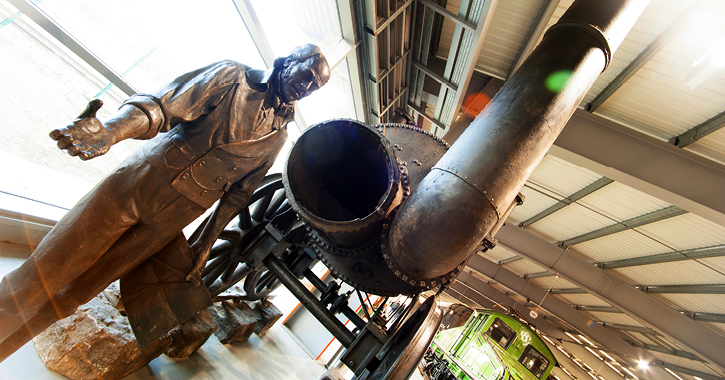
George Stephenson’s engine Locomotion No.1 pulled the train, made famous by this feat. Equally important Locomotion No.1 is also celebrated as the first railway engine to use coupling rods to connect its driving wheels, an significant milestone in the safety of the railways. To learn about Durham’s fascinating railway past, and the railway town of Shildon, take a de-tour and visit Locomotion.
The Finchale Camino continues southwards through West Auckland to Gainford, skirting land once owned by the Anglo-Dane King of England, King Canute who reigned England from 1016 to 1035 and Denmark from 1019 to 1035. More of King Canute and his pilgrimage to Durham Cathedral and the Shrine of St Cuthbert can be discovered on The Way of Love which starts in Hartlepool travelling west to Durham.
Gainford is on the north bank of the River Tees and has a long association with healing waters. It is appropriate that shortly before arriving at Gainford, the Finchale Camino passes by Headlam Hall Country Hotel & Spa. It’s a fabulous place for a well-earned rest towards the end of the walk, or even better to return to once you have completed the Finchale Camino.
One story of how Gainford acquired its name tells of a dispute of who controlled an ancient river crossing, a ford across the River Tees. Two communities, one of the north side and one on the south side of the river both claimed to own the crossing rights. The issue was eventually resolved with a battle. The north side won and therefore ‘gained’ the ford.
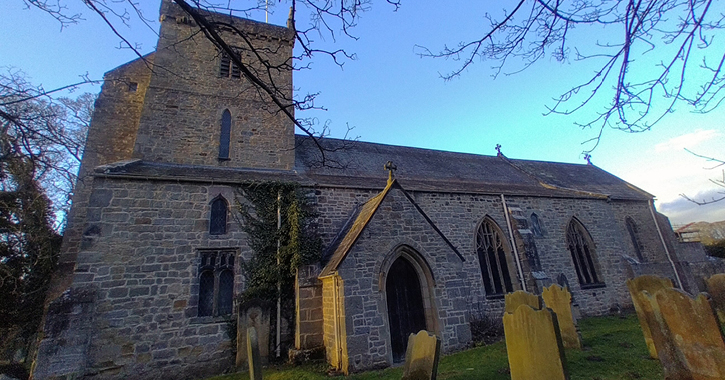
This delightful village was once famed as a Victorian spa. It’s association with healing waters dates back centuries, possible a millennium or more. St Mary’s Well, found on the south side of the village church, St Mary’s, is possibly on the site of a pagan well. The existing church dates from the 13th century. An earlier known church at Gainford was built by Bishop Ecgred of Lindisfarne in the 9th century.
St Mary’s Church has some fascinating Anglo-Danish and early medieval carvings. Its north porch incorporates a Viking grave cover into a seat as well as other carvings found during 19th century repairs to the church. Other carvings and grave covers from the area can be seen in the Museum at Durham Cathedral.
A remnant of the village’s Victorian spa can be found along a footpath to the west of the village on the banks of the River Tees. A working fountain and basin remain.
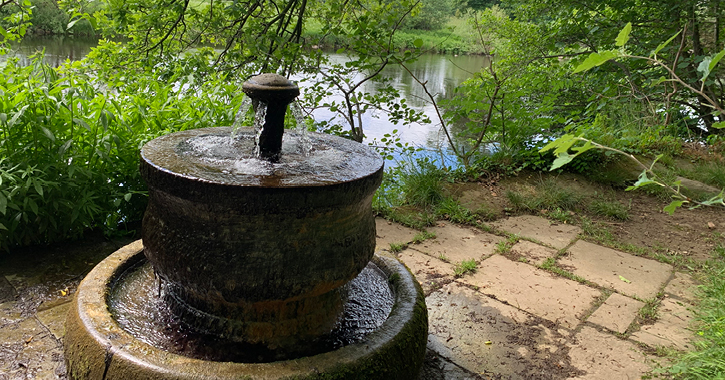
All that remains is to wish you “Buen Camino” or “Good Way”, the greeting shared by pilgrims who walk the Camino.
Whether walking south through Durham on the Finchale Camino or north on the Way of Life, a fascinating pilgrimage ‘a journey with intent’ awaits.
Related
Comments
Comments are disabled for this post.
.png)

 to add an item to your Itinerary basket.
to add an item to your Itinerary basket.









